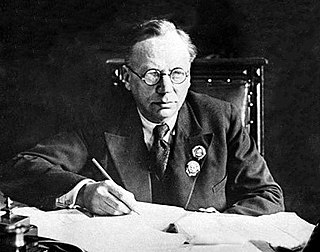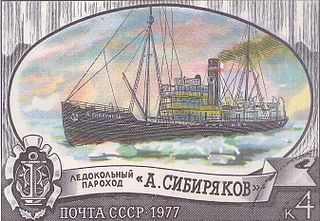
The Northeast Passage is the shipping route between the Atlantic and Pacific Oceans, along the Arctic coasts of Norway and Russia. The western route through the islands of Canada is accordingly called the Northwest Passage (NWP).

The Laptev Sea is a marginal sea of the Arctic Ocean. It is located between the northern coast of Siberia, the Taimyr Peninsula, Severnaya Zemlya and the New Siberian Islands. Its northern boundary passes from the Arctic Cape to a point with co-ordinates of 79°N and 139°E, and ends at the Anisiy Cape. The Kara Sea lies to the west, the East Siberian Sea to the east.

Sadko was a Soviet icebreaker known for its role in scientific expeditions in the Arctic. Built as SS Lintrose in 1913 for ferry service in Newfoundland, she was sold to the government of the Russian Empire in 1915 and renamed Sadko. In Russia, she was used as a freighter in the Arctic before sinking in 1916.

Baku was one of six Leningrad-class destroyer leaders built for the Soviet Navy during the 1930s, one of the three Project 38 variants. Completed in late 1939, the ship was assigned to the Pacific Fleet. About a year after the German invasion of Russia in June 1941, she was ordered to join the Northern Fleet, sailing through the Arctic Ocean. Together with several other destroyers, Baku left the Soviet Far East in July 1942 and arrived off Murmansk three months later where she began escorting convoys, mostly in the White and Barents Seas. The ship was badly damaged in a storm that sank another Soviet destroyer in November and was under repair for several months. Baku spent most of the rest of the war on convoy escort duties, although she did bombard several German-occupied towns during the Petsamo–Kirkenes Offensive of October 1944. The ship and her crew were awarded the Order of the Red Banner in early 1945 for their performance during the war.

The Nordenskiöld Archipelago or Nordenskjold Archipelago is a large and complex cluster of about 90 islands in the eastern region of the Kara Sea. Its eastern limit lies 120 km (75 mi) west of the Taymyr Peninsula. The archipelago is part of the Taymyrsky Dolgano-Nenetsky District of the Krasnoyarsk Krai administrative division of Russia.

Vladimir Yulyevich Wiese was a Russian scientist of German descent who devoted his life to the study of the Arctic ice pack. His name is associated with the Scientific Prediction of Ice Conditions theory. Wiese was a member of the Soviet Arctic Institute and an authority on polar oceanography. He was also the founder of the Geographico-hydrological School of Oceanography.

Russky Island, also spelt Russkyy and Russkiy, is an island in the Kara Sea. It is located in the Litke Islands subgroup of the Nordenskiöld Archipelago.

Vladimir Ivanovich Voronin was a Soviet Navy captain, born in Sumsky Posad, in the present Republic of Karelia, Russia. In 1932 he commanded the expedition of the Soviet icebreaker A. Sibiryakov which made the first successful crossing of the Northern Sea Route in a single navigation without wintering. This voyage was organized by the All-Union Arctic Institute.

The Komsomolskaya Pravda Islands are an archipelago in the far north of the Russian Federation. The islands are uninhabited and are covered with tundra vegetation, shingle and ice.

The icebreaker Fyodor Litke was active in the Soviet era in the Arctic, until the late 1950s. It was built in 1909 in England for the Saint Lawrence River service and initially named CGC Earl Grey after Albert Grey, Governor General of Canada. After four years in Canada it was sold to the Russian government and eventually renamed Fyodor Litke in honour of the Arctic explorer Fyodor Petrovich Litke.

Operation Wonderland was an operation from 16 to 30 August 1942 by the Kriegsmarine in the Barents Sea and the Kara Sea off the Arctic coast of the Soviet Union. The operation was an attack on Soviet shipping using the Northern Sea Route which ran along the Soviet Arctic coast from the Bering Strait, westwards along Siberia to the Kara Sea. The operation was the first part of a campaign to dominate the seas of the western Arctic. Reports from Japanese naval intelligence alerted the Germans to the sailing of a convoy, EON-18.

Alexander Sibiryakov was a steamship that was built in Scotland in 1909 as Bellaventure, and was originally a seal hunting ship in Newfoundland. In 1917 the Russian government bought her to be an icebreaker. She served the RSFSR and Soviet Union until 1942, when she was sunk by enemy action. The ship gave notable service in the Russian Arctic during the 1930s.

Taymyr was an icebreaking steamer of 1,200 tons built for the Russian Imperial Navy at Saint Petersburg in 1909. It was named after the Taymyr Peninsula.

Icebreaker Vaygach was an icebreaking steamer of moderate size built for the Russian Imperial Navy at Saint Petersburg in 1909. She was named after Vaygach Island in the Russian Arctic.
Steamer Pravda was a Soviet merchant freighter of about 3,100 tonnes displacement, which was active in the Soviet Arctic during the 1930s. This ship had been normally used for carrying timber. It was named after Soviet newspaper Pravda.
SS Volodarskiy was a Soviet freighter of about 3,100 tonnes displacement which was active in the Arctic during the 1930s. This ship had been normally used for carrying timber.

The Faddey Bay is a gulf in the Laptev Sea on the eastern coast of the Taymyr Peninsula. It measures about 47 km from its innermost point in the southwest, the delta of the Pregradnaya River, to its broadest opening to the sea in the northeast. Its average width is 21 km.

Fyodor Andreyevich Matisen was an officer of the Russian Imperial Navy, hydrographer, and explorer.














